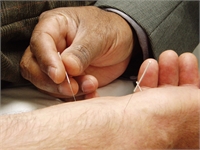
What You Should Know About Acupuncture
Important Notice: Our web hosting provider recently started charging us for additional visits, which was unexpected. In response, we're seeking donations. Depending on the situation, we may explore different monetization options for our Community and Expert Contributors. It's crucial to provide more returns for their expertise and offer more Expert Validated Answers or AI Validated Answers. Learn more about our hosting issue here.

What You Should Know About Acupuncture
You must be logged in to post a comment.
Ancient Beginnings
Since first introduced to the United States in the mid-1800s, the logic and scientific basis for acupuncture has largely escaped Western sensibilities. Believing that it has no scientific basis and is rooted in ancient superstition, many prominent American doctors of the twentieth century related its perceived effectiveness to the placebo effect–whereby virtually any method of physical contact would have been equally successful. But as tens of thousands of Americans are now discovering, acupuncture is remarkably effective in treating a number of health conditions.
Rooted in ancient Chinese healing principles, acupuncture is known to have been in practice for at least 2500 years. While its specific origin is unknown, one theory suggests that at some point it was observed that some soldiers who had been wounded by arrows in battle were mysteriously cured even though their injuries had been left untreated. Some scholars also suggest that the healing principles behind acupuncture may be traced as far back as the Stone Age, when Bian shi, or sharpened stones were employed to treat ailments. Hieroglyphs and pictographs from the Shang Dynasty suggest that acupuncture was practiced as early as the twelfth century BCE.
Based on the Eastern philosophy that health depends on a vital energy lifeforce called qi (or ch’i) which flows through the body along 14 specific pathways called “meridians,” acupuncture asserts that if your qi isn’t flowing correctly due to blockage (or is being diverted), pain and disease soon follow. The strategic insertion of needles at various points along the meridians effectively unblocks your qi flow and restores your body to a state of energetic balance.
Modern Discoveries
Within the past decade, the National Institutes of Health (NIH) has conducted extensive research into the effectiveness and principles of acupuncture, and have made several surprising discoveries.
In addition to achieving astonishing results relating to relief of pain after dental surgery and in alleviating nausea and vomiting associated with chemotherapy, studies also indicate that when inserted properly, acupuncture needles can help end the pain of menstrual cramps, tennis elbow, fibromyalgia, lower back pain, osteoarthritis, headache, and a number of other common conditions resulting in chronic pain. And they believe that’s just the beginning of the healing possibilities.
In one study conducted at the University of Pennsylvania Medical Center, it was proven that when accurately placed, acupuncture needles have a marked affect on the flow of blood in the brain. Using SPECT (single photon emission computed tomography) to view the brain activity of four subjects suffering pain and five who were pain-free (who served as the control group), it was discovered that when needles were inserted along the prescribed meridians, all the subjects experienced increased blood flow to the thalamus, the area of the brain that relays pain signals and other sensory information. Because the brains of the pain-free group showed the same reactions as those who were experiencing pain, the changes in blood-flow could not be attributed to the so-called “placebo affect.” Thus science sees no limit as to what other positive effects acupuncture can have on patients’ health conditions with this approach as the basis.
Today there are an estimated 18,000 licensed acupuncturists in the United States, approximately one-third of whom are physicians.
Unlike their professional predecessors, twenty-first century doctors have adopted an entirely different perspective concerning the use of acupuncture, with many now regularly referring their patents to acupuncturists (or are themselves expanding their medical repertoire to include this ancient modality).
And while much of the less enlightened sector of the American population is still hesitant to subject themselves to “the needles,” those who have are this ancient-yet-new health science’s best and most vocal advocates. More and more people are seeing the benefits of using a healing method that eliminates the need for drugs, is almost always less expensive than doctors’ visits, and leaves the body in balance rather than invading it with harmful chemicals or invasive surgery.